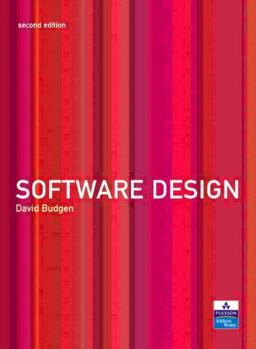Software Design
Select Format
Select Condition 
Book Overview
Software Design: Creating Solutions for Ill-Structured Problems, Third Edition provides a balanced view of the many and varied software design practices used by practitioners. The book provides a... This description may be from another edition of this product.
Format:Hardcover
Language:English
ISBN:0201722194
ISBN13:9780201722192
Release Date:May 2003
Publisher:Addison Wesley Publishing Company
Length:468 Pages
Weight:2.05 lbs.
Dimensions:1.2" x 6.7" x 9.6"
Customer Reviews
4 ratings
The many facets of and approaches to software design
Published by Thriftbooks.com User , 20 years ago
As I am constantly telling my software-engineering students, the writing of the code now takes up somewhere between 10 and 20 percent of the effort put into software projects. Since development environments are constantly improving and allow some of the routine features of the code to be automatically written, this percentage will no doubt continue to drop. This is a very solid trend, as relatively more time is being spent on capturing and refining the requirements and constructing a design that incorporates the proper amount of flexibility. This flexibility is needed so that changes can be made in the project in response to the customers and developers learning more about what the software should do. There are several different approaches to the design process, from the make-it-up-as-you -go style to the construction of a rigid design at the start that cannot be altered after that. This spectrum is covered, although for obvious reasons, the two extremes are only slightly covered. The emphasis is on the approaches that are dynamic with a plan, where there is an initial detailed design, but with adequate room for change. The book is split into three parts:* The role of software design.* Transferring design knowledge.* Design practices.The first section is basically a justification for the inclusion of an extensive design phase in a software project. It starts at the very basic level, answering simple questions such as "What is design?" and "What is software?". While this may seem trivial, it is not. Design is a concept that is interpreted in many ways, which requires that it have some form of formal definition. The second section covers the topics of how a design is articulated, which includes how it is represented and how the knowledge is transferred to others. It is very good that so much time was spent in this area. One of the main points of failure in projects is the communication of ideas from one team to another. The best possible design is of little value if the design team cannot effectively communicate their results to the production team. The last section is a listing of some of the most common design practices in use today. Techniques such as stepwise refinement, incremental design, designing with objects and component-based design are described. Two design methods created by Michael Jackson, called Jackson Structured Programming (JSP) and Jackson System Development (JSD) are also examined. In my experience of following the trends in books, I see the "traditional" coverage of software engineering being split into distinct sections. Software engineering textbooks are growing in size and there are now books on software architecture, software design and software testing. This book is a sound introduction to the area of design and if your goal is to teach a course in that area or just learn more about it, then it will serve you well.
Excellent and comprehensive coverage of a large subject
Published by Thriftbooks.com User , 20 years ago
This book provides a comprehensive overview of software design. Most valuably, it deals with the nature and principles of software design, rather than the details of particular approaches. It's the only book I've seen that addresses professional issues in software design, such as how knowledge is passed on to new designers, and the real purposes and usage of software processes.This second edition now has substantial coverage of object oriented approaches to design. Chapter 16 is a sixty-page primer in OOD that sets OOD in the context of other approaches. Few others have even attempted to do that.My only negative criticism is that the writing style tends towards the academic, and there is a little too much of "we will deal with this in Chapter X". But the book is still very readable. The material is fascinating, and extremely valuable to me as a practising professional in this field.Best book I've read on the subject.
clear, complete structured design sections
Published by Thriftbooks.com User , 23 years ago
also provides insight into booch-like designs. as an experienced c programmer, I found this book very useful.
Excellent Survey of Software Design Before Objects
Published by Thriftbooks.com User , 24 years ago
This book is a very good survey of pre-object-oriented design techniques (as well as some object-oriented design techniques in their early stages of development). This book is also a good book on Programmer Art History. If you really want to understand the pre-history of object-oriented design, read this book. If you are a collector of acronyms, this book is a must.





